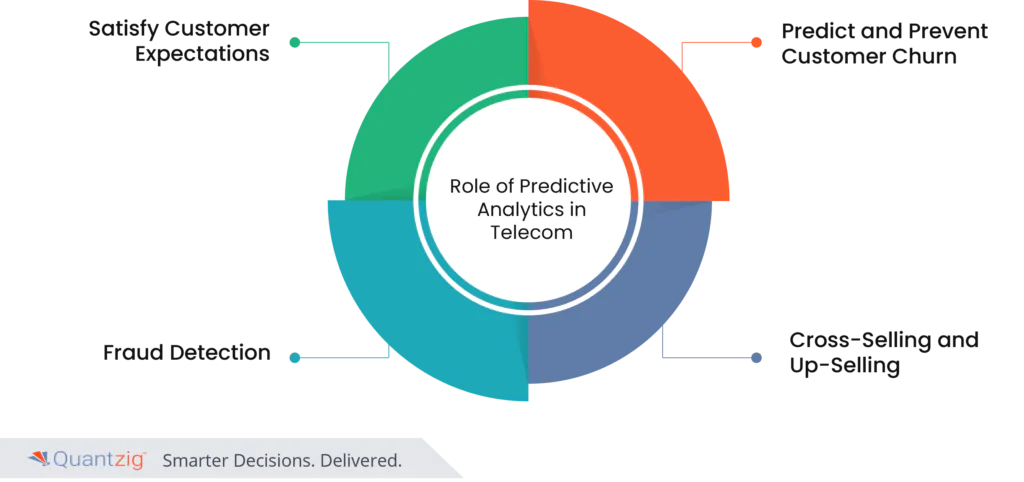The telecom industry is experiencing rapid transformation, driven by continuous technological advancements and the growing demand for seamless connectivity. What was once seen as a sector focused primarily on infrastructure is now at the forefront of enabling communication, information exchange, and interaction across the globe.
As competition heats up, telecom providers face the challenge of staying ahead in a saturated market while meeting ever-evolving customer expectations. To maintain their competitive edge, telecom companies are increasingly turning to telecom data analytics, predictive network maintenance, network optimization, and telecom big data to enhance their services, reduce costs, and deliver more personalized experiences.
By leveraging tools such as telecom customer segmentation, real-time telecom analytics, and telecom fraud detection, providers can optimize their networks, improve service quality, and prevent costly disruptions. Advanced solutions like predictive modeling for telecom, telecom revenue forecasting, and network downtime prediction help businesses make informed, data-driven decisions, ensuring both operational efficiency and customer satisfaction.
In this blog, we’ll explore how these emerging technologies are reshaping the telecom landscape and positioning companies for long-term success.
Book a demo to experience the meaningful insights we derive from data through our analytical tools and platform capabilities.
Request a DemoTable of Contents
What are Big Data Analytics and Why Does it Matter?
Big data analytics refers to the process of examining and interpreting vast and complex datasets to uncover hidden patterns, unknown correlations, market trends, and valuable business insights. In the telecom industry, where data is generated in enormous quantities every day—from customer interactions to network performance—big data analytics is an essential tool. By analyzing large volumes of diverse data, telecom companies can make data-driven decisions that not only improve operational efficiency but also enhance the customer experience.
With the growing number of connected devices, internet of things (IoT) innovations, and high-speed data networks, telecom companies are dealing with more data than ever before. This explosion of data offers an opportunity to use advanced analytics to extract actionable insights, predict future trends, and shape business strategies. Here’s why big data analytics is critical for telecom providers:
| Why It Matters | Explanation |
|---|---|
| Customer Satisfaction | Predictive analytics helps telecom providers anticipate customer needs, offer personalized services, and proactively address issues, improving satisfaction and retention. |
| Churn Prevention | By analyzing customer behavior patterns, predictive analytics can identify at-risk customers, enabling targeted retention efforts and reducing churn, as demonstrated by Cox Communications. |
| Fraud Detection | Big data analytics helps detect suspicious activities through data mining algorithms, allowing telecom providers to identify and prevent fraud, protecting revenue. |
| Cross-Selling & Up-Selling | Predictive analytics enhances cross-selling and up-selling by analyzing customer transaction histories, enabling telecom companies to offer targeted services that boost revenue and strengthen loyalty. |
Benefits of Predictive Analytics in Telecom
Telecom companies are increasingly leveraging predictive analytics to gain a competitive edge. By harnessing data and analytics, telecom providers can anticipate customer needs, enhance network performance, and streamline operations. Using data analytics tools and an advanced analytics platform, companies can process vast amounts of data in real-time, leading to more informed decision-making and improved customer experiences.
Enhancing Customer Experience
Predictive analytics helps telecom companies understand customer preferences and behaviors. With the power of data analytics tools and a robust analytics platform, providers can offer personalized services, resolve potential issues before they occur, and proactively support customers. This tailored approach boosts customer satisfaction and fosters loyalty.
Reducing Customer Churn
Customer churn is a major concern for telecom providers. By utilizing predictive analytics on an analytics platform, companies can identify at-risk customers based on behavioral patterns. This enables targeted retention strategies, such as personalized offers or timely interventions, helping reduce churn and increase customer lifetime value.
Optimizing Network Performance
Predictive analytics is also crucial in optimizing network performance. Through data analytics tools, telecom companies can predict traffic surges and detect potential network issues before they impact service. By addressing bottlenecks proactively, providers can ensure smoother, more reliable connectivity, enhancing user experience and operational efficiency.
By incorporating predictive analytics across these key areas, telecom providers can stay ahead of the curve, improve customer retention, and optimize network efficiency.
Challenges of Big Data Analytics in Telecom:
While big data analytics offers numerous advantages, it is not without its challenges. Telecom companies must overcome several hurdles to fully leverage the power of analytics:
1. Data Privacy and Security:
Handling vast amounts of sensitive customer data requires robust security measures to safeguard privacy and prevent data breaches.
2. Integration of Legacy Systems:
Telecom companies often grapple with the challenge of integrating new big data analytics systems with existing legacy systems, ensuring seamless operations.
3. Skill Shortage:
The demand for skilled professionals in big data analytics surpasses the current supply, creating a skills gap in the industry.
4. Infrastructure Costs:
Building and maintaining the infrastructure required for effective big data analytics can be a significant investment for telecom providers.
Get started with your complimentary trial today and delve into our platform without any obligations. Explore our wide range of customized, consumption driven analytical solutions services built across the analytical maturity levels.
Start your TrialTrends in Data Analytics in the Telecom Industry:
-
Edge Computing:
With the rise of IoT devices and the need for real-time analytics, telecom companies are increasingly adopting edge computing to process data closer to the source, reducing latency.
-
AI and Machine Learning Integration:
Telecom providers are leveraging AI and machine learning to enhance predictive analytics, automate processes, and gain deeper insights into customer behavior.
-
5G Optimization:
The deployment of 5G technology is generating massive amounts of data. Telecom companies are focusing on analytics to optimize 5G networks, improve performance, and deliver a seamless experience.
-
Customer Journey Analytics:
Understanding the complete customer journey, from browsing to purchasing, is a growing trend. Telecom companies are employing analytics to gain holistic insights into customer interactions and preferences.
Use Cases of Predictive Analytics in the Telecom Industry

1. Satisfy Customer Expectations
One of the guiding principles of customer experience management is to look at how customers are engaging at every stage with the organization. This includes interactions before they sign on as customers, all the way through the end of their engagement with the company. The goal is to understand the customer’s experience and taking measures to shape it in the most positive way possible. In other words, it’s about anticipating needs and delivering services that keep customers happy, rather than reacting to problems. With the help of predictive analytics, telecom companies can accurately identify the trends in customers’ needs. This will help providers to alter their services accordingly and improve the customer experience.
2. Predict and Prevent Customer Churn
Did you know that certain predictive analytics software even recommends ways to reverse trends such as churn? This can be taken into account when companies in the telecom industry are devising strategies to reduce or avoid churn. For instance, Cox Communications, a leading player in the telecom industry had built predictive models that enabled them to quickly and precisely poll millions of customer observations and hundreds of variables to identify issues including the likelihood of churn. They then personalized offers across 28 regions. By acting upon the insights and recommendations, the provider was able to reduce its customer churn.
3. Fraud Detection
Fraud is a key root cause of lost revenue in the telecom industry. Efficient fraud detection systems can help telcos save a significant amount of money. Fraud detection systems depend on data mining algorithms to identify and alert telcos to fraudulent customers and suspicious behavior. While data mining techniques help only in the areas of subscription fraud, it is useful to remember that there can be several methods of fraud, requiring other analytic models to aid detection. Risk management teams are the largest users of fraud management systems.
4. Cross-Selling and Up-Selling
Cross-selling and up-selling activities can be supported by predictive analytic in the telecom industry by tracking association rules and transaction histories. Analytics-driven cross-selling and up-selling campaigns are known to provide comparatively higher returns. By moving beyond financials, they also increase stickiness and reduce the number of contacts required for cross-selling and up-selling.
Conclusion: Why Predictive Analytics is a Game-Changer for Telecom
Telecom companies are increasingly leveraging telecom data analytics and predictive analytics software to enhance operational efficiency, improve customer experiences, and gain a competitive edge. predictive maintenance in telecom, network performance analytics, and telecom network optimization play pivotal roles in ensuring network reliability and performance.
By adopting advanced telecom predictive modeling and customer behavior prediction in telecom, providers can proactively address issues, improve service quality, and reduce churn through telecom customer churn prediction strategies. Additionally, telecom fraud detection and telecom revenue forecasting enable secure operations and financial stability.
The integration of predictive analytics for telecom operations, network traffic prediction, and telecom service quality prediction ensures seamless service delivery. Furthermore, telecom demand forecasting, telecom customer segmentation, and predictive analytics in telecom marketing empower personalized offerings and targeted campaigns.
As the telecom landscape continues to evolve, adopting telecom big data analytics through an advanced analytics platform is crucial for unlocking growth opportunities. Investing in predictive analytics for customer retention and telecom fault prediction ensures improved decision-making and operational excellence. Quantzig’s expertise in data analytics in the telecom industry can help telecom providers stay ahead of emerging trends and deliver superior services.
Experience the advantages firsthand by testing a customized complimentary pilot designed to address your specific requirements. Pilot studies are non-committal in nature.
Request a Pilot



